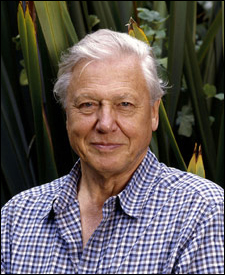The bird as art – and artist
David Attenborough proclaims beauty and creativity of New Guinea’s birds
Throughout their history, artists have looked at birds and tried to make them soar on paper with pen and paint. According to renowned British naturalist and

documentary filmmaker Sir David Attenborough, though, there are birds so lovely and ingenious they can justifiably be categorized as art – and even artists – themselves.
Before a standing-room-only crowd at Sanders Theatre, Attenborough, a former director of programs for the BBC and conceiver of the landmark television series “Life on Earth,” accepted the 2004 Roger Tory Peterson Medal, given every year by the Harvard Museum of Natural History in memory of the pioneering ornithologist and author. He then delivered the award’s memorial lecture.
In honor of Peterson’s skill as an illustrator of birds, Attenborough filled his presentation with colorful drawings and clips from his recent documentary on New Guinea’s birds of paradise. When Magellan first brought the skins of these birds back with him to Spain in 1522, he said, their plumes of gossamer and gold astonished his countrymen. Curiously, their carcasses had no wings and no legs. The Spanish speculated that the birds needed no limbs because they floated magically through the skies of paradise. (In truth, New Guinea’s natives so treasured the plumes that, to show them off, they removed the birds’ limbs and then used the feathers as a type of currency.)
“When I started making films of the natural world (in 1955), the one thing I wanted to do more than anything else was to film the dance of the birds of paradise,” Attenborough said.
It was only a few years ago that Attenborough got his chance. He showed the audience the result: a film clip of the mating dance of the “miraculous birds” and their beauty, which had so entranced 16th century Europe. A female opens her plumes. They explode in bright white and yellow as she searches for a mate. Several males gather, flap wings and bow to the female with their heads down. She settles on the perch of the male of her choice. He jumps at her and retreats, then seems to bat her on the head a number of times before mounting her briefly and flying away.
Attenborough said that early European naturalists competed vigorously for the dried skin and plumes of the tropical birds. They found it almost impossible, however, to extrapolate the birds’ mechanics from their skins alone. In fact, until just a few years ago, scientists could still explain the function of much of these birds’ unusual anatomies only through the speculations of the naturalists who drew them centuries before.
To illustrate his point, Attenborough showed a slide of the male of one species. The drawing showed a dozen strange quills that bent back behind the bird in a tangle. For decades, ornithologists wondered what could possibly have been the use of these wiry appendages.
Several years ago, Attenborough filmed the answer to this question. He showed the rapt audience a clip of a male and female of the species doing a mating dance. The male brushes his quills against the face of the female in a sort of seduction. The female apparently responds as much to the tactile as she does to the visual appeal of the bright saffron color of the male’s plumes. The two mate.
The extraordinary things about New Guinea, Attenborough asserted, are its newness (in geographic terms) and isolation. Exploiting the island’s absence of predators, the birds display their breathtaking colors in the air, in trees, and even on the ground. Attenborough showed a slide of a drawing by the British naturalist John Gould. The bird sits on the ground, displaying a breast of golden feathers. Over many generations, Attenborough said, natural selection favored males who’d acquired such fabulous plumage.
But nature rewards behavior as well as physical attributes, Attenborough said. Looking on from the podium, he showed a clip of a dark black male bird. The audience chuckled as the bird hopped through the forest, clearing debris from its path. As females gather, he spreads his wings, and dances back and forth, revealing a golden patch high up on his breast. A female is drawn in by the jig and the two birds mate.
Some species that do not have the benefit of brilliant plumage actually decorate themselves. Attenborough rolled some footage of a navy blue bird that decorates himself with green moss and leaves. The bird even chews up some bright blue berries, expels the juice and “paints” himself in order to attract a mate.
Attenborough closed with a slide of a cone-shaped sculpture created by the noted British contemporary artist Andy Goldsworthy and constructed almost entirely of twigs. He then showed a slide of the bower of one of New Guinea’s male birds of paradise. The structure was almost identical in shape to Goldsworthy’s and used the same materials.
He switched back to a picture of the modern art piece.
“If that is art,” he said of the Goldsworthy, then flashed to the shot of the bird’s bower, “Why is not that art? And if [the bird’s bower] is art, then hail to the bird as artist!”
The Roger Tory Peterson Memorial Lecture was established by the Harvard Museum of Natural History in 1997 in order to keep the memory of this pioneering naturalist alive. Past recipients of the award include Edward O. Wilson, Jared M. Diamond, Paul R. Ehrlich, Bruce E. Babbittt, Richard Leakey, and Peter Matthiessen.




